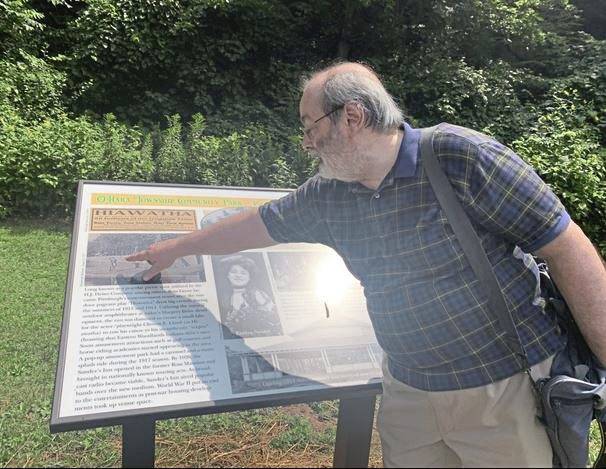Markers installed in O'Hara Community Park to provide glimpse of local history
The U.S. Army’s 308th Calvary trained on land that now houses O’Hara Community Park.
The land, in a nine-parcel estate that totaled 1,923 acres, was later owned by U.S. Senator James Ross.
A picnic area known as Ross Grove became Pittsburgh’s entertainment resort, utilized by the H.J. Heinz Company, among others.
These tidbits and many others are highlighted on the historical markers erected last week in the park along Fox Chapel Road.
“This area has a lot of history that we want to amplify with these signs,” local Historian Tom Powers said.
He is the author of O’Hara’s history book, “Portrait of an American Community,” and was among a small committee of experts who drafted the signs.
They worked with members of the Council of Three Rivers American Indian Center (COTRAIC) in Indiana Township and The Seneca Iroquois National Museum in New York.
Signs were vetted by both the museum and the Sen. John Heinz History Center in Pittsburgh, township Manager Julie Jakubec said.
“It is hoped that folks learn about the vibrant and diverse history of the township,” she said.
The cost of the project was about $5,000, Jakubec said.
Six permanent signs that are 4-feet by 3-feet were installed around the park’s walking trail.
They travel through the history of the township starting near the entrance to the sand volleyball pit.
The signs were spurred by council’s vote to rename the park after petitions called for the removal of the former title, Squaw Valley Park. Some people said the word “squaw” was a slur to Native American women.
That happened in July 2020 and the committee has been working since to draft an accurate history of the township, tracing to prehistoric times and other much-regaled eras such as when Seneca Indian Chief Guyasuta traversed the region serving as a consultant to George Washington.
Miguel Sague, a COTRAIC board member, is an artist who helped illustrate the markers.
He believes it was the right decision for council to change the park name but also offer visitors a wider, more accurate depth of township history.
The signs detail the cultural influences from Native Americans, like many of the names of nearby rivers and towns — Kiskiminetas, Allegheny and Kittanning.
“They had incredible influence over this area,” Powers said.
The final sign in the series gives readers a glimpse into business tycoon Robert Hall, who essentially saved the park by buying the property from the government, Powers said.
Powers noted that designs for the park have stayed mostly true to their original 1965 opening draft.
Jakubec hopes that more signs will be added throughout the township parks to raise interest in local history.
A formal dedication of the markers is eyed for October.
Tawnya Panizzi is a TribLive reporter. She joined the Trib in 1997. She can be reached at tpanizzi@triblive.com.
Remove the ads from your TribLIVE reading experience but still support the journalists who create the content with TribLIVE Ad-Free.

